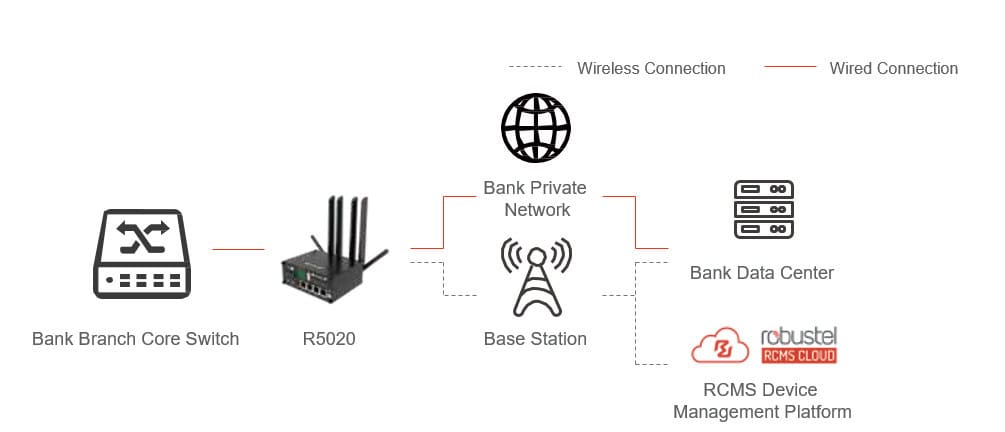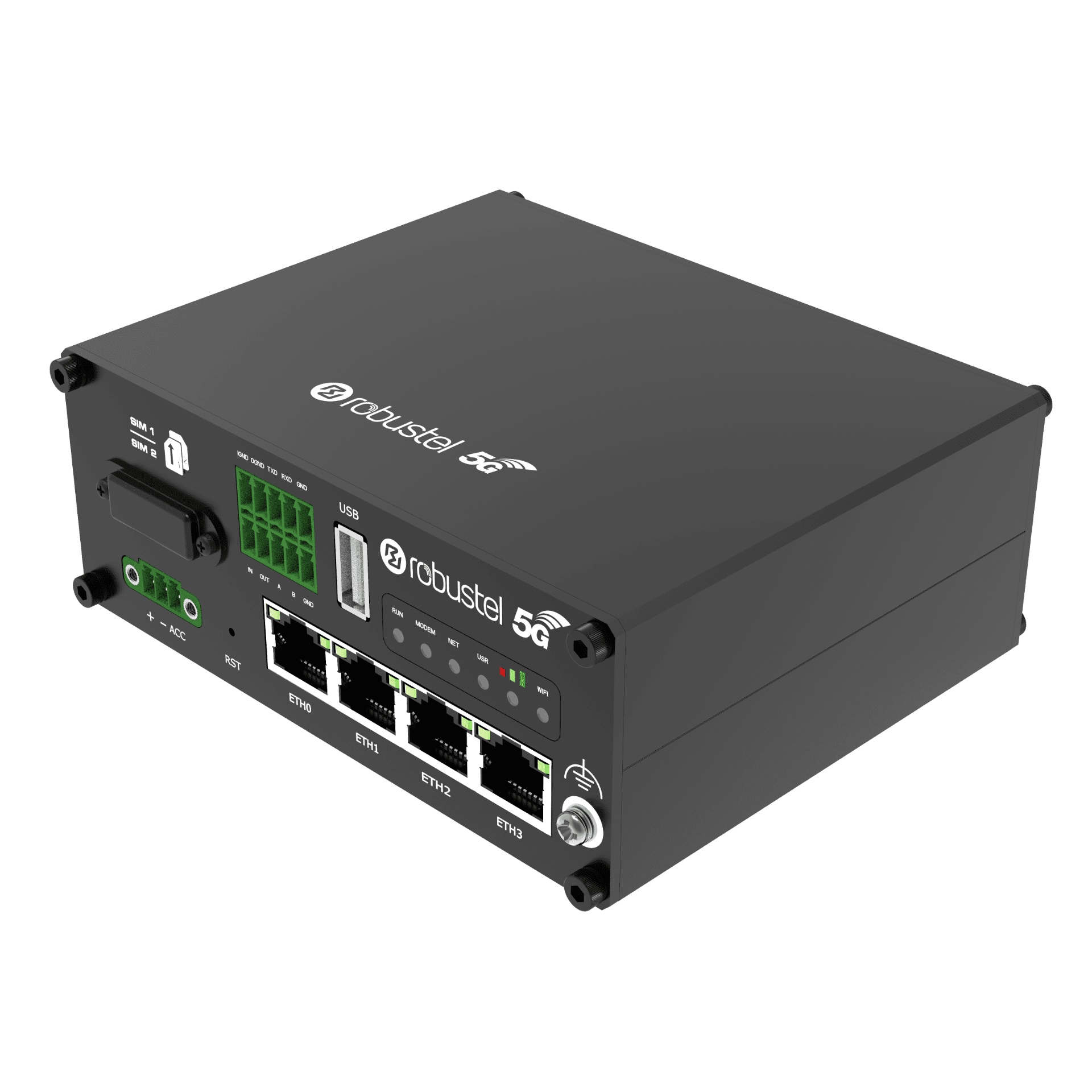High Speed Branch Office Routing over 5G with the R5020
A Robustel Application Example
Application Example – Fast Facts
Industry
Enterprise IT, Retail & Payments, Financial Services
Product(s)
R5020 5G Router, RCMS
Challenges
Branches need rapid, secure connectivity without waiting on fixed-line installs. Teams must standardize rollout, keep payment and corporate networks segmented, and maintain visibility for support and compliance—across dozens or thousands of sites.
Expected Outcomes
Day-one turn-up on 5G with automatic failover, consistent security policies, clean remote access for IT, and clear health/usage insights. Rollouts become predictable, on-site work drops, and SLAs stabilize.
When branches can’t wait for circuits
A vending or self-service kiosk only earns when it is online. Card payments need a clean path to the processor. Telemetry needs to arrive on time so replenishment aOpening or refitting a branch should not hinge on carrier lead times. Many organizations now use 5G as the primary link, then add fixed line when it arrives; others keep 5G as a permanent secondary path to protect card payments, back-office apps, and voice. Either way, the branch needs a single, dependable edge that is quick to deploy and simple to operate.
The R5020 provides 5G New Radio backhaul with 4G fallback, dual-SIM resilience, and Gigabit Ethernet for LAN and WAN. Paired with cloud management and a clean VPN overlay, it gives IT teams day-one service, centralized control, and the guardrails they need for audit and uptime.
Business Challenges
Modern branch networks face a mix of practical and governance pressures. Here’s what typically blocks speed and reliability—and why a 5G-first design helps.
- Circuit lead time: Fixed-line installs delay openings and refits; workarounds create one-off configurations that are hard to support.
- Uptime expectations: Payments, ticketing, and back-office systems must keep running through carrier outages and maintenance windows.
- Addressability for remote support: Branch devices often sit behind carrier-grade NAT; IT needs stable, secure access for diagnostics and changes.
- Consistent segmentation: Point-of-Sale (POS), guest Wi-Fi, cameras, and staff devices require clear separation to reduce risk and scope during audits.
- Operational overhead: Truck rolls for configuration and firmware updates consume budget and pull engineers off higher-value work.
- Performance variability: Radio conditions change by location and time; IT needs visibility and policy controls to keep user experience predictable.
Solution Overview

A standardized branch template is built around the R5020 as the edge router. Sites activate on 5G immediately and use dual-SIM for carrier diversity; Ethernet WAN is added when available. A VPN overlay provides fixed addressing and least-privilege access. Cloud management handles Zero-Touch onboarding, monitoring, and controlled updates—so IT operates the fleet as one system.
- 5G primary with dual-SIM resilience: R5020 brings the branch up on 5G on day one; two SIM profiles provide carrier diversity and automatic failover.
- Clean path for remote access: A VPN overlay (e.g., IPsec or OpenVPN) gives stable addressing and role-based access to branch assets for support tools and engineers.
- Segmentation that matches risk: VLANs and policy separate POS, corporate devices, cameras, and staff/guest Wi-Fi to contain faults and simplify compliance scope.
- Add fixed line when ready: Ethernet WAN is enabled when the circuit lands; policy defines which services prefer fixed line versus 5G, with failover in either direction.
- Zero-Touch onboarding: Devices ship pre-enrolled; on power-up they pull configuration and firmware from the cloud so local installers don’t need network expertise.
- Fleet visibility and control: Cloud dashboards surface uptime, signal, data usage, and change history; scheduled updates roll out in rings to reduce risk.
- Operational guardrails: Browser-based CLI for surgical fixes, activity logs for audit, and alerting so issues are handled before they disrupt the branch.
Expected Customer Outcomes
A successful deployment is judged by uptime, speed to open, and total effort over the lifecycle not just day-one throughput. The measure of success differs by role; here’s how it lands for each stakeholder.
What success looks like for the key stakeholders and the secondary stakeholders
- Head of IT / Network Operations: Predictable branch turn-ups, stable SLAs, and clear evidence of changes. One policy set governs many sites; fewer escalations and fewer emergency visits.
- Security & Compliance Lead: Segmented networks, encrypted management paths, and auditable access. Scope for assessments is contained and artifacts are easy to produce.
- Branch / Store Operations: Payment terminals, tills, and staff systems stay online during carrier or circuit incidents. Openings and refits proceed on schedule.
- Field Technicians / Managed Service Provider: Standard templates, Zero-Touch provisioning, and remote diagnostics reduce time on site and repeat visits.
- Finance / Procurement: Lower time-to-revenue for new sites, fewer unplanned costs, and the flexibility to mix 5G and fixed line without redesign.
Featured Products
Robustel R5020 5G Router

RCMS Cloud Device Management

Talk to an Expert
Design a branch template you can deploy repeatedly with day-one 5G, clean remote access, and policies that keep payments and corporate traffic safe. Speak to an expert and we’ll map the approach to your sites, tools, and rollout plan.
